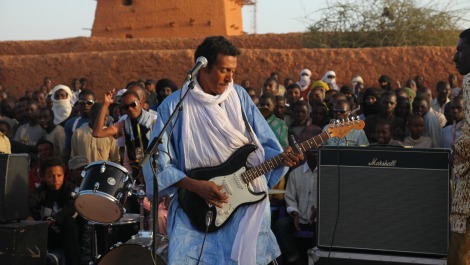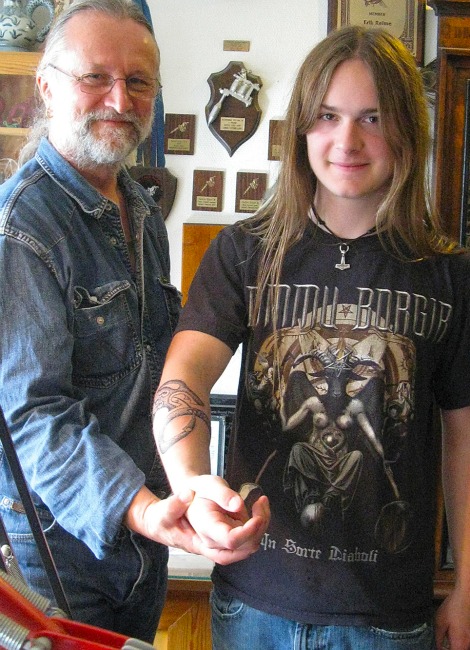
SUB-SAHARAN HOMESICK BLUES
It’s a one of those universal truths: whether you’re cruising the
cactus-studded Pearblossom Highway, snapping your fingers to the dulcet
rockabilly-laments of Heavy Trash’s latest, or camper-waltzing through
the majestic Rockies while the score to Kubrick’s
A Clockwork Orange
blares from the rear speakers, no road trip is complete without the
appropriate musical accompaniment and it’s all the better when that
soundtrack chooses you. The highway of human consciousness certainly had
an auditory detour in mind for documentary filmmaker Ron Wyman when he
visited Africa back in 2007. Introduced to Wyman via his Berber guides,
five wobbly, homespun guitar jams would become the accidental score to
his next storytelling saga.
“I was working on a film about Tuareg nomads and wound up going over
to Africa with an NGO that a good friend had been involved with,”
explains Wyman. “I spent a month driving around this spectacular desert,
100 miles from the nearest road, building a narrative about them. They
had one homemade cassette with a handful of recordings on it by a
guitarist called Bombino. That tape was all that we listened to for two
weeks straight and I never got tired of it. It was the perfect
soundtrack to that incredibly magnificent region.”
A longtime fan of rock and blues music, Wyman was hooked. He knew he
had to find a way to contact Bombino, who is also known as Omara Moctar
or Goumar Almoctar, and to capture the enigmatic guitar maestro’s exotic
artistry on film. Unfortunately, this was during a period of terrible
social and political upheaval for Bombino’s homeland of Niger. Known as
The Guitarists to the government of then-President Mamadou Tandja,
Bombino and his fellow Berber bards were condemned as cultural
propagandists for the rebelling Tuaregs. Following the murders of two of
his bandmates, Bombino fled to Burkina Faso in order to escape the
growing threat of violence. For Bombino, this episode was tragically
reminiscent of his family’s flight to Algeria during the first Tamasheq
rebellion seventeen years earlier.
“It took me the course of a year to track him down,” Wyman recounts.
“By the time I got to Niger, he had left the country because he was
being harassed by the military. When I finally caught up to him, he was
at a home that belonged to some of his fellow Tuareg ex-pats. We hit it
off immediately. He was sweet and shy. He had been driving a taxi
between gigs and didn’t have a lot of confidence about his abilities. He
started playing some music at the house and I saw him transform into
this amazing, confident, beautiful entertainer. When I heard that music
got a chill, and by the time I was done filming that song I realized,
‘Wow! He is more extraordinary than I thought!’ ”
Casanova of the Sahel
Bombino’s hypnotic manipulation of the
high-and-airy West African guitar style parlays hardship into harmony.
Multi-textured forays into the Afro-rock genre, which call upon
progressive references to Clapton, Hendrix and Page, challenge any
notion of geographic or spiritual isolation. Like Malian world music
sensations Tinariwen, Bombino’s timeless voice echoes the ongoing
struggles of his people (who call themselves as the Kel Tamasheq) whilst
celebrating an inner strength and a heritage that is as boundless as
the dunes.
“Omara (Bombino) brings in whole new elements to the tribal songs of
these traditional stewards of the Sahara. There’s 100 years of history
behind his music, but it was the way in incorporates modern guitar licks
that blew me away,” Wyman explains. “Up in the Northern regions of
Niger, the people are very poor, but everybody has clamshell cell phones
with a couple of megabytes of stored music. They walk up and down the
street playing these tinny reproductions and the music spreads by way of
phone, cassette and word-of-mouth. They love to hear their own stories
as reflected by their own musicians, so guys like Bombino and the other
Tuareg musicians have a cult-like following. You could see people’s eyes
light up when you mentioned Bombino. He represents something to the
youth: a new breed, a new generation. That’s how he got the name. They
called him, ‘the bambino, the young one.’ ”
Founder of ZeroGravity Films, Wyman has produced and directed
numerous documentaries about global issues and the performing arts. 16
years of experience with CNN’s political division tempered by freelance
work with media rogues like Michael Moore and Bill Maher has given Wyman
a powerful directorial skill set that balances intellect with
romanticism. Focusing his camera obscura upon Bombino’s provocative yet
utterly appealing creations, he has successfully revealed the nomadic
troubadour to a global audiences with the release of his film,
Agadez, the Music and the Rebellion,
in 2011. Sensible enough to capitalize on an all-too-rare opportunity,
Wyman and Bombino also crafted a complimentary soundtrack CD by the same
name, filled with the vivid biopic’s mystical, psychedelic,
desert-rock.
“Every now then, you find yourself in the presence of someone and you
know you’ve got something special. Bombino is like this. His guitars
aren’t the best, but he’s got these long, adept fingers and a voice that
really strikes you every time you hear it!”
Wyman continues. “I was convinced that in addition to a film we’d have to make a CD. That’s how
Agadez came about.
Agadez
was my first CD production, although I have done several docs on
musicians, including Tunde Jegede and Babatunde Olatunji. I am a
musician myself, so music plays a big role in all of my work.”
Calmer conditions in Niger have facilitated this Prince-in-Exile’s
return, but Bombino’s work is never done. An ambassador for change, the
now 32-year-old desert bluesman continues to encourage his Tuareg
tribesmen to push back against a rising tide of pro-extremist sentiment
spilling over from neighbouring nations. Embracing his role as an
influential figure on the international stage, Bombino (a boy who grew
up admiring Western guitar gods) looks forward to touring the world and,
one day, his own country.
“Even with an enthusiastic new government in place, dealing with the
bureaucracy of Niger is a real headache,” Wyman acknowledges. “So, one
night we rented generator and construction lights and headed 15 miles
out into bush to film a live Bombino concert. We were totally amazed
that so many people came out to see him perform in the middle of
nowhere. That night he showed us his true soul. He played that acoustic
guitar like Jimi Hendrix and John Lee Hooker, but in his own
incomparable style.”
Tapped for distribution by international music label
Cumbancha Records,
Agadez
(so named for Bombino’s birthplace) received widespread critical
acclaim. The soundtrack-album debuted at the top of the iTunes World
Chart in April of 2011 and the website subsequently dubbed him
“Breakthrough World Music Artist of 2011.”
“Touring with Bombino, I’ve seen him accepting his celebrity status
in a subconscious way. Not in an ego sense, but taking responsibility
and becoming tremendously more confident. It’s in his Tuareg nature to
want to run against the grain. They don’t want to be told how to worship
or that their women should cover faces. Mainstream Tuareg don’t want
anything to do with that, they completely reject the horrible things
that have been happening in Chad and Mali. The Tuareg are trying to
separate themselves from al-Qaeda’s influence and Bombino has been
paying attention to their desire to secure Niger’s borders. His words
have a tremendous impact, he dreams of touring to promote unity within
Niger. Bombino definitely has his head screwed on right. As a Tuareg, he
is very centred and self-dependant. The world could learn a lot from
them.”
Relocated to exotic Nashville to embark on the recording of a new CD,
Wyman confirms that Bombino plans to release his second full-length
album in the spring of 2013.
“I believe that Agadez will be Bombino’s signature CD, having a certain authenticity from being recorded in
Agadez,”
Wyman observes. “The new CD is an evolution: it will really put him on
the map. He’s really stepped up to the plate with this new material,
still maintaining Tuareg themes, but exploring his own sound and taking
it to the next level. He is a rare talent: you can identify his unique
and beautiful style by hearing a few seconds. It is hard to know the
literal themes he is working on, as all his songs are sung in Tamashaq,
but if the rough mixes are any indication of what’s to come, I can’t
wait to hear the rest. He’s really going for it and doing lot more with
his technique. For me, it reaffirms what an incredible talent he is.”
By Christine Leonard
Originally published via Beat Route Magazine July 2012

















